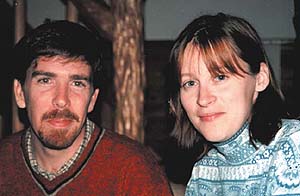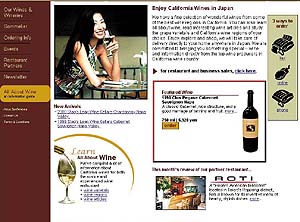Just-in-Time Wine
Back to Contents of Issue: August 2002
|
|
|
|
by Michael Turner |
|
 WHEN ADAM SMITH FAMOUSLY branded England "a nation of shopkeepers" he could just as easily have been referring to Japan at any time over the last 50 years. While the stores are still in place, change is clearly afoot in this country. The dreary lines of shops along the back streets have, over the last decade, been squeezed by convenience stores, chains like Starbucks, chic boutiques and an ever-widening array of restaurants sporting ever-lengthening menus for a beverage that seems to define upscale Western taste: wine. WHEN ADAM SMITH FAMOUSLY branded England "a nation of shopkeepers" he could just as easily have been referring to Japan at any time over the last 50 years. While the stores are still in place, change is clearly afoot in this country. The dreary lines of shops along the back streets have, over the last decade, been squeezed by convenience stores, chains like Starbucks, chic boutiques and an ever-widening array of restaurants sporting ever-lengthening menus for a beverage that seems to define upscale Western taste: wine.While the 'wine boom' has subsided here, growth is steady. Japanese sommeliers even outnumber their French counterparts by about five to one. Onto this stage stepped SanSonoma.com, an IT-savvy importer of California wines. Soon after setting up in Tokyo a couple of years ago, the company discovered what Japan market-entry experts tire of explaining: They weren't in Kansas anymore. Distribution channels can be byzantine. Restaurateurs needed more advice. Storage space was dramatically tighter. Brand image for unknown products was harder to define and harder to control. SanSonoma.com found relief in the form of Chris and Lauren Shannon, who had been looking for financing for their dream business: to help traditional Japanese crafts find a global market through the Web. They found no takers among venture capitalists for that idea, but were steered toward another opportunity: to help SanSonoma adapt to the Japanese market. It takes a certain sense of adventure to try to make a go of it in Japan. The Shannons had plenty of that and so they set out for scenic Shikoku in July 1997. Lauren, with degrees in English and education, and some teaching experience under her belt, decided to try her luck with the Japan Exchange and Teaching (JET) program, sponsored by the Japanese Education Ministry. Her husband Chris, having just sold his computer-aided design (CAD) startup to John Brown Engineering, and having lived in Honduras and El Salvador for seven years as a Special Forces radio operator in the US military, was also ready for a new adventure. Lauren soon found her feet as an organizer: She was soon a regional president representing the JET program's foreign teachers, and she organized events including a benefit rock concert for Habitat for Humanity. Chris quickly found work with Shikoku-Kiki, a local company dealing in trucks, generators and ATM machines that was getting into outsource software development. "It was really good for getting a sense of business in Japan," he says. Both learned Japanese quickly working and living on Shikoku. It was on Shikoku that the Shannons developed their love of the way the Japanese make certain things, especially washi (handmade paper), soy sauce, fans and -- their favorite -- handmade candles. VC money was not following traditional crafts. It was, however, following imported wines. Soon after meeting with the people at SanSonoma.com, the Shannons were working on a way to modernize the company's distribution system and tweak it to fit the unique needs of Tokyo's restaurants. "We modernized SanSonoma's IT operations from Tokyo," Chris says. "It was like doing plumbing with the water running." There is more to this than just localization. Take storage space. One thing they learned was that they could make more sales if they adjusted the system to allow for mixed cases -- more than one kind of wine packed into the same box. Inventories have to run tighter here, especially considering the wide varieties of wine SanSonoma offers.  "Look at Roti in Roppongi," says Lauren of the trendy Tokyo restaurant. "Fifty eight wines on their menu -- as many as New York Grill -- in a quarter the storage space." This means fewer bottles of the same wine, lower minimum-reorder quantities and more frequent shipments. "'Just-in-time wine' is our slogan," she says.
"Look at Roti in Roppongi," says Lauren of the trendy Tokyo restaurant. "Fifty eight wines on their menu -- as many as New York Grill -- in a quarter the storage space." This means fewer bottles of the same wine, lower minimum-reorder quantities and more frequent shipments. "'Just-in-time wine' is our slogan," she says.They named their system Mercury after the messenger of Roman mythology. The key technology, according to Chris, is XML, from the ASP to the cash register. "Restaurateurs complain that their systems aren't flexible; the range of reports they can produce are limited; they are not really restaurant-oriented," he says. Worse, what few system-tailoring tools are available seem to be vendor-specific. "They're 10, 15 years behind here," he says. He looked to XML to provide the needed flexibility. "We need just-in-time over disparate systems," he says, and Mercury is compatible with four major point-of-sale systems already. Wine being a perishable product, flexibility is king. Mercury records when a bottle has been opened so that the remains can be retired to the kitchen for cooking after three days. Reordering takes place automatically at the end of the evening, rather than the next day. The checking of inventory and ordering of wine no longer has to be done manually in the bleary, weary wee hours. It didn't take the Shannons long to see that they were onto something that could fly on its own as a startup business. They decided to leave the California wine distributor -- a departure they call "amicable" -- and go it alone. They found another partner and set up a company called Mikan Solutions early this year and are now busy building their tangerine dream. @ |
|
Note: The function "email this page" is currently not supported for this page.






